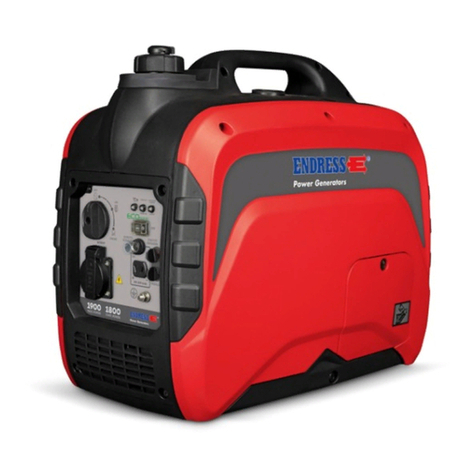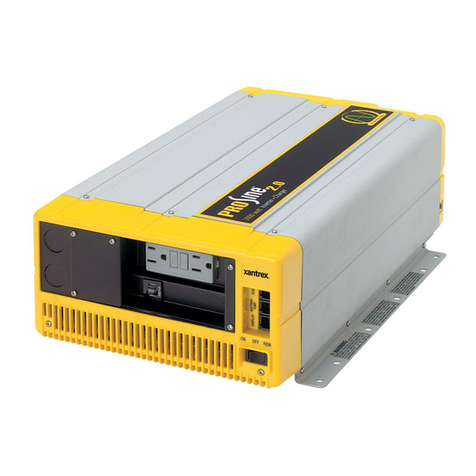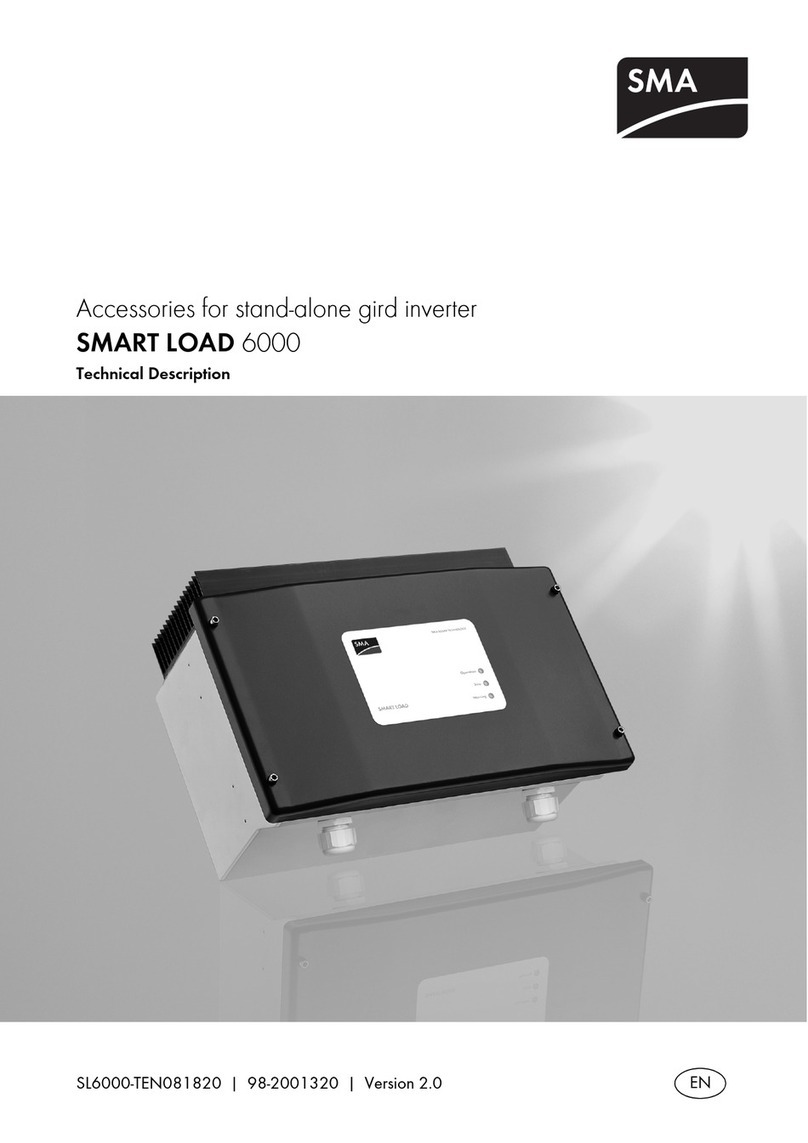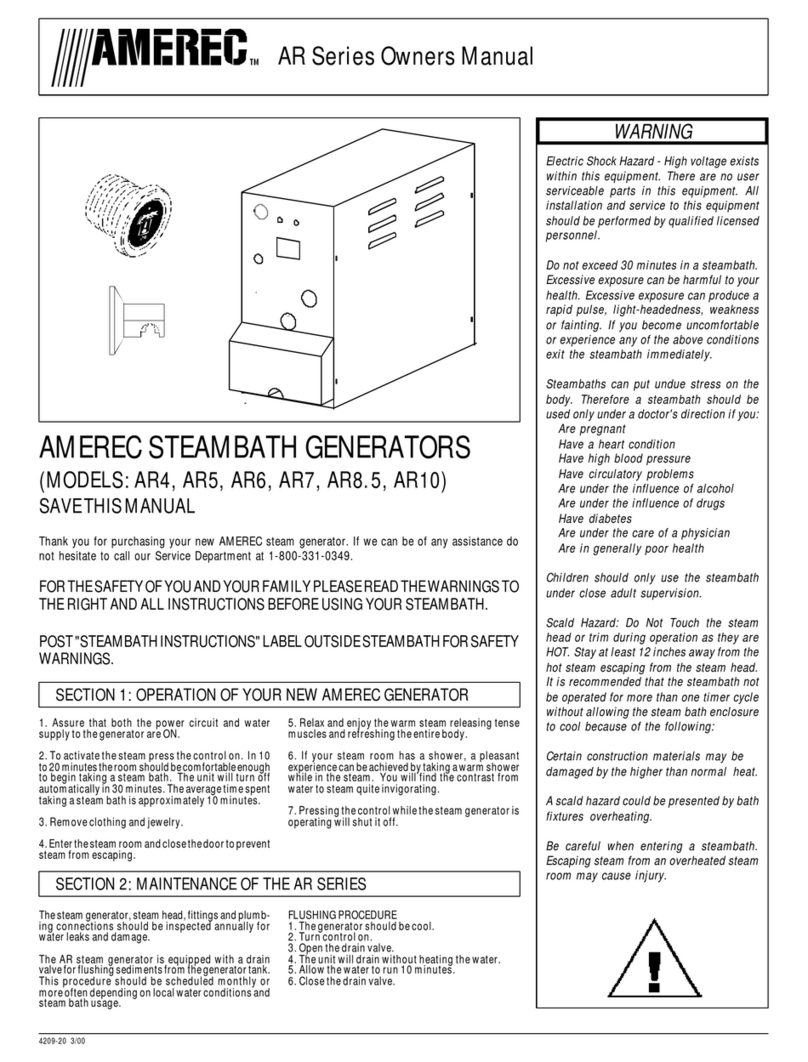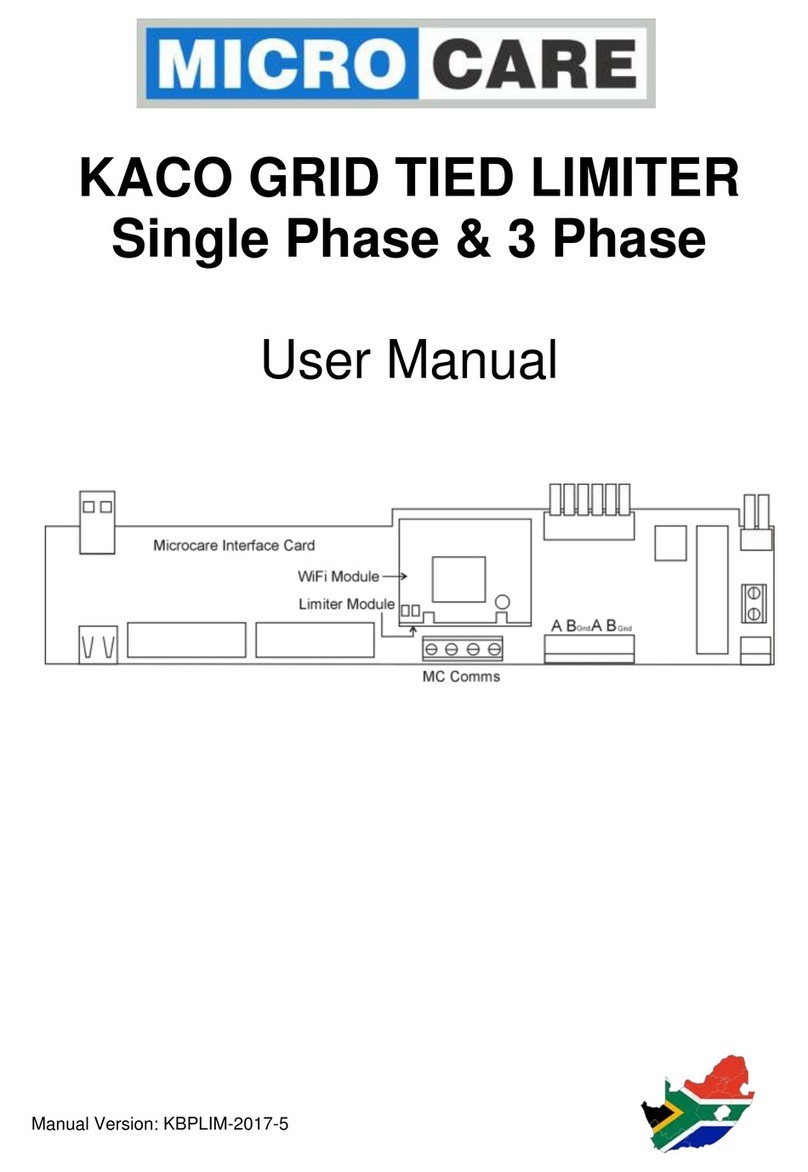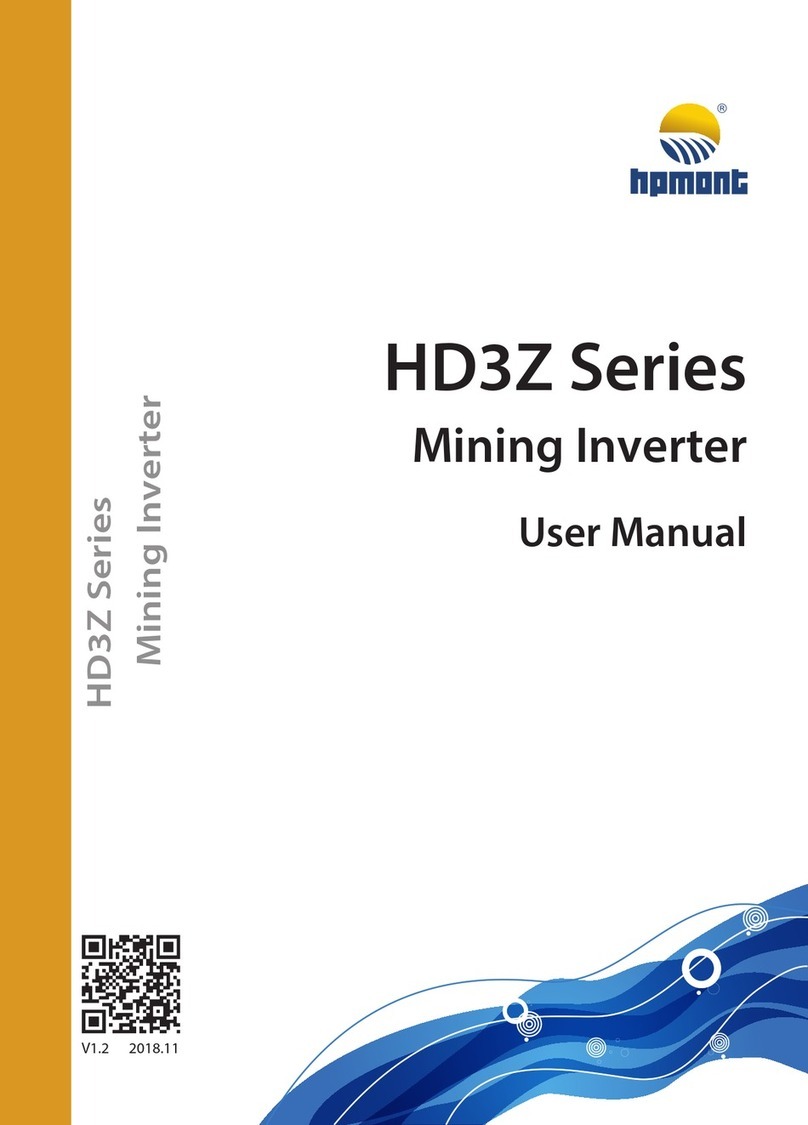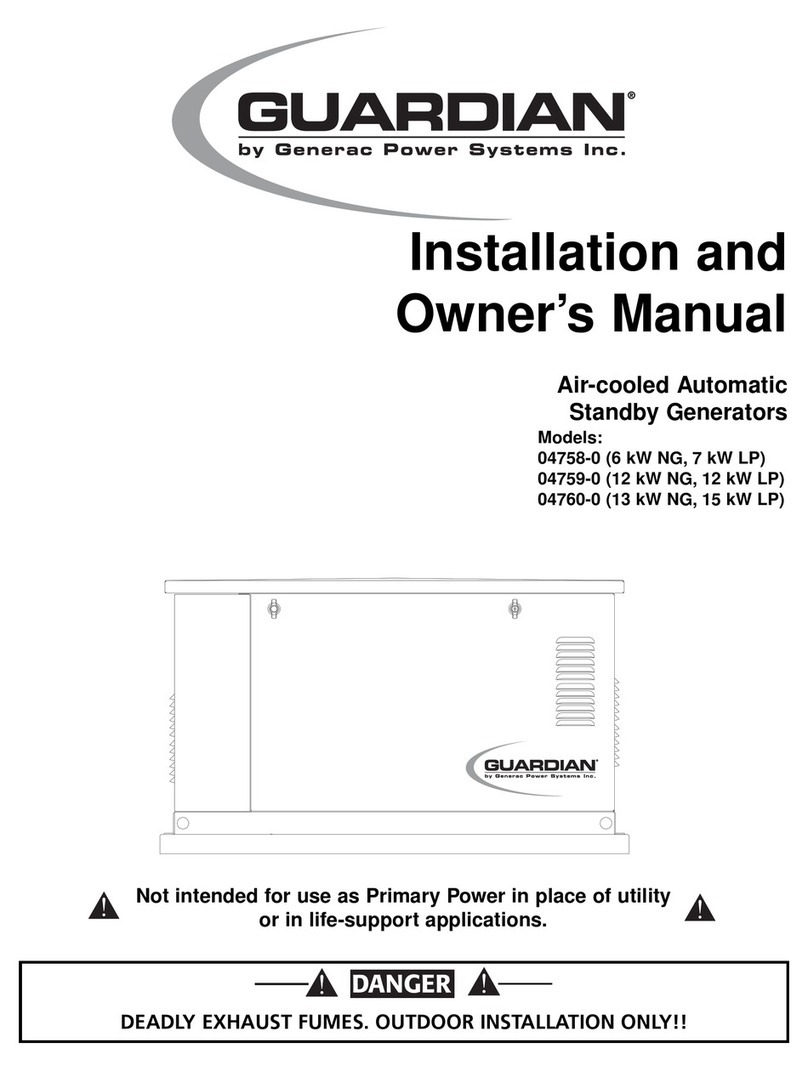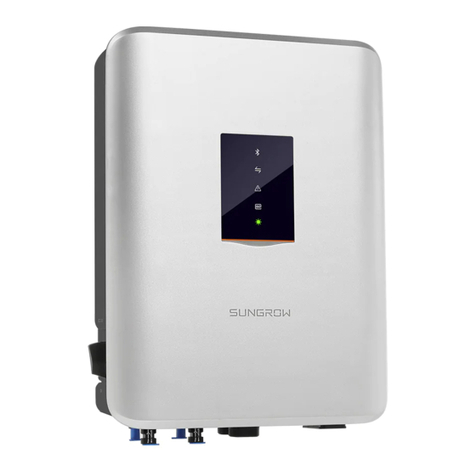Advanced Energy Industries RFX 600 User manual

THE
ADVANCED
ENERGY®
RFX
600 GENERATOR
User Manual
ADVANCED ENERGY
INDUSTRIES, INC
1600 Prospect Parkway
Fort Collins. Colorado
80525
(303) 221-4670
Telex #45-0938
PN:
5705008-8
June
1991

To
ensure years of dependable service, Advanced Energy® products
are
thoroughly tested and designed to be among the most reliable and highest
quality systems available worldwide.
All
parts and labor carry our standard
1-year warranty.
For Customer Service, call:
AE,
Colorado office
AE,
California office
AE,
Japanese office
AE,
German office
all
others
(303)
221-0108 (24-hour
line)
Fax:
(303) 221-5583
(408) 263-8784
(8
a.m. to 5p.m. Pacific
Standard Time -California only)
Fax:
(408) 263-8992
81
(03)
3222-1311
Fax:
81
(03)
3222-1315
49 (0711) 777-87-18
Fax:
49 (0711) 777-87-00
contact your local service
center-see
the
list
on the next page
©1990, Advanced Energy Industries, Inc
All rights reserved. Printed
in
the United States of America.
This
manual
is
supplied to enable the reader
to
safely install, operate, and service the
equipment described herein. Making copies of any part of this manual for any
purpose other than these is aviolation of U.S. copyright law.
In
the interest of providing even better equipment, Advanced Energy
Industries, Inc., reserves the right to make product changes without
notification
or
obligation.
For more information, write Advanced Energy Industries, Inc., 1600 Prospect
Parkway, Fort Collins, CO 80525.

l.
2.
3.
4.
5.
safe'ty
.
General
~iption.
Specifications
.
Front
Panel
Display
Rear
Panel
Display.
TABlE
OF
CONI'ENI'S
Page
No.
6
7
7
9
9
6 •
Connectors.....................................
10
7.
Diagnostic
Connector
Table
8.
9.
Input
PcMer
Connectors
.
Analog/digital
I/O
Connections.
Pin-description
Table
..
Signal
~iptions
....
D::
Bias.
D::
Bias
Regulation
...
First
Time
Operation.
Unpacking
start-up
....•.••.
10
10
10
12
16
17
18
20
20
20
10.
Troubleshooting
.
21
Warranty
3

******
WARNING
******
SAFE
O~
IRXE:IJRES
AND
IRJP!:R
lEE
OF
'lliE
mJIIMENI'
ARE
'!HE
RESKNSmn..r.I'Y'
OF
'mE
USER OF
'IRIS
SYSTEM.
Advanced
Energy
Irrlustries,
Inc.
provides
information
on
its
prcrlucts
arrl
associates
hazards,
but
it
assumes
no
responsibility
for
the
after
sale
operation
arrl
safety
practices.
AIL
PERSONNEL
WHO
IDRK
wrrn
OR
ARE EXFOSED
TO
'!HIS
ECPIfMENT
MUST
TAKE
PRECAurIONS
TO
PROTECT
'THEMSELVES
AGArnST
Fa3SIBIE
SERICUS AND/OR FATAL EODILY
INJURY.
5

1.
SAFE'IY
'!be
high
voltage
nature
of
the
outp..rt
of
these
~
sut=Plies
dictates
the
use
of
caution
when
near
the
ootp.,rt
pa...'er
connection.
Precautic:ns:
1) Make
certain
that
the
chassis
is
properly
grc:mrled.
'lEE
GR.XJND
~OO
IR:JVIIE)
SB:lJI.D
lUI'
BE IEFEATEJ!
2)
'!be
ootpJt
connector
is
no:rna1.1y
grourrled.
VOIXllGE
lEVElS
Kl?
'lliE
a::NNE:CIUR
MAY
BE
M::.RE
'llWl
1000
VOIll'S
I:IJRn«;
O~CN.
All
internal
adjustments
may
be
made
with
the
tq:> cover rercxwed
but
with
the
safety
plexiglass
shield
in
place.
After
adjustments
are
completed,
the
top
cover
should
be
replace::1
prior
to
turrJ.irB
on
the
po.ver
supply.
6

2.
GENERAL
DESCRIPTION
The
RFX
600
is
a
two-stage
power
generator
using
aFetpower™
modular
power
amplifier
and
a
switchmode
dc
power
supply
for
main
power
and
control.
The
RFX
is
designed
for
80%
reflected
power
capability.
It
regulates
output
power
using
either
forward
power
or
dc
bias
of
the
load.
Its
features
allow
it
to
be
used
alone
or
in
combination
with
other
supplies
(through
common
exciter
mode)
in
such
configurations
as
RF
with
RF
bias,
RF
with
dc
bias,
and
dc
with
RF
bias.
3.
SPCIFICATIONS
Power
Output:
600
watts
maximum
into
a
50
ohm
load.
Harmonic
Distortion:
All
harmonics
are
more
than
50dB
below
the
fundamental.
Noise,
hum
and
ripple
are
down
by
30dB
or
greater
below
the
fundamental.
Freguency:
13.56MHz
±
0.005%
Output
Impedance:
50
ohms
output
Power
Regulation:
variation
from
1:
1
to
limits).
±
3%
of
power
setting
for
any
load
VSWR
10:
1
resistive
(wi
thin
auto
protection
Load
Mismatch
Tolerance:
mismatch
without
failure.
continuous
operation
into
any
load
Pulsed
Operation:
Frequency
range
from
zero
to
10KHz maximum.
Rise
and
fall
times
are
less
than
2.0
microseconds.
PUlsing
input
is
CMOS
15V
compatible.
Unit
is
capable
of
simultaneous
and
independent
RF
amplitude
control
and
pulse
operation.
Protection:
Automatic
foldback
occurs
when
voltage,
current
or
dissipation
exceeds
preset
limits.
Unit
capable
of
up
to
400
watts
reflected
power
mismatch
without
foldback.
Unit
is
completely
protected
from
hardware
damage
due
to
open
outputs.
RF
Power
Control:
0
to
600
watts
with
front
panel
control
or
remote
0
to
5
volt
command.
Maximum
Power
Limit:
Adjustable
limit
from
zero
to
maximum
output
prevents
excessive
output
during
remote
operation.
Front
panel
setscrew
adj
ustment.
setting
may
be
observed
on
front
panel
digital
display.
Automatic
Forward
Power
Setting:
externally
controlled.
o
to
600
watts
internally
or
7

Efficiencv:
Variable
switchmode
dc
input
combined
with
Class
D
Fetpower™
output
provides
a
minimum
60%
overall
efficiency
from
100
watts
to
600
watts
output
into
50
ohms
resistive.
Regulation:
Forward
power
or
dc
bias
of
the
load.
Input
Power:
115
VAC
+
10%
or
230
VAC
±
10%
single
phase,
50/60
Hz.
Dual
Supply
operation:
unit
may
operate
either
as
master
or
slave
or
independent
mode
by
logic
level
selection
through
a
user
connector
on
the
rear
panel
(common
exciter
-"CEX TOGGLE") .
Remote
Operation:
A
user
connector
(25-pin
subminiature
D-type)
is
provided
on
the
rear
panel
to
allow
remote
operation
or
computer
interface.
Diaqnostic
Connector:
Rear
panel
subminiature
(IS-pin
subminiature
D-type)
connector
provides
sufficient
information
to
troubleshoot
a
problem
to
an
internal
module
level
without
the
need
to
open
the
cover.
Cooling:
Forced
air;
maximum
inlet
ambient
temperature
is
40°C.
Temperature
monitors
protect
the
unit
from
fan
failure
or
airflow
blockage.
Size:
6.97
in.
(17.70
cm)
Height
8.50
in.
(21.59
cm)
Width*
17.75
in
(45.09
cm)
Deep
*Add 2
inches
(5.08
cm)
to
include
removable
rack
ears
Weight:
26.5
lbs.
(12
Kg)
RF
Output
Connector:
Type
"N"
8

4.
FR:NI'
PANEL
DISPIAY
Control
IUiER
-
energizes
unit.
FWRD
FWR
(left)
display)
an:l
REFL
FWR
(right
display)
light
up.
Displays
lEFT
DISPIAY -
controls
status
of
left
display.
Each
ti.ne
the
push
button
is
pressed,
the
display
cycles
tl1rc:xJgh
FWRD
FWR,
an::i
OC
BIAS.
RIaII'
DISPIAY -
controls
status
of
right
display.
Each
ti.ne
the
push
button
is
pressed,
the
display
cycles
tl1rc:xJgh REFL
FWR,
MAX
FWR
an:l
HiASE ANGLE.
Re;:rulation
FWD
RtlR
1.CW)
:Rtm -
provides
forward
~
regulation
control.
OC
BIAS
LeW)
:Rtm -
provides
dc
bias
regulation
control.
Hole
above
this
push
button
is
a
set
screw
adjustment
to
scale
the
dc
Bias
Control
from
0-1000.
FWD
p,.m;oc
BIAS -
pressed
t.cxjether
provides
a
load
pa.ver
regulation
control.
5.
REAR
PANEL
DISPlAY
2
aJC
Connectors:
CEX cur -
13
.56MHz
outp.rt
signal
frem
the
exciter
sub-assernbly.
Used
in
dual
system
operation
as
a
master
outp.J.t
to
keep
both
units
in
tylase.
CEX rn -
13.56MHz
inp.rt.
signal
to
the
pa.ver
anplifier
sub-assernbly
of
the
slaved
unit
in
a
dual
system
to
keep
both
units
in
~.
Circuit
Breaker
The
circuit
breaker
must
be
on
to
operate
the
unit.
9

Irn:::yt
Pc:1Ner
Connections
'Ihe
st:.arrlard
inp..It.
~
is
115V,
8.
SA,
sin~Ie-P"Jase,
SO/60Hz.
Analcx:J/digital
110
Connections
'Ihe
user
I/O
interface
uses
a
2S-pin,
D-type
connector.
All
analcg
signals
are
O-S V
in
am
out.
All
digital
signals
are
0-IS
V
ODS
carpatible.
Pin-descri.ptiCl1
Table
Pin
Narre
Description
See
page
1
OC
BIAS.A +(+)
Differential
analcg
feedback
12
i.np..It.
for
de
bias
regulation.
2
OC
BIAS.A -
(-)
Differential
analcg
feed
back
12
input
for
de
bias
regulation.
3OFF/RESET.D
Digital
rerrote
input
off/reset
12
CCil'll'l'aIrl.
Referenced
to
pin
19.
4
ON.D*
Digital
rerrote
input
on
e::atIrlEl"rl.
12
Reference::1
to
pin
19.
SroI..SE
ON.D
Digital
rerrote
input
p.llse
output
13
CCil'll'l'aIrl.
Ref
erence::1
to
pin
19.
6CEX 'ItX3GLE. D*
Digital
input
enable
for
cornroc>n
13
exciter.
Referenced
to
pin
19.
7
FHASE
ANGIE.A
Analcg
input
representation
of
phase
13
angle.
Referenced
to
pin
18.
8
FHASE.D
(+)
(-)
Digi
tal
input
representation
in::licating
13
the
sign
of
the
P1ase
angle,
based
on
a
user-provided
signal.
Reference::J.
to
pin
19.
9
PIASMA.D
Digital
input
in:iication
of
plasma
13
presence
fran
ATX
tuner.
Referenced
to
pin
19.
10 I.DAD
~
ill.A
Analcg
inplt
representation
of
load
13
p:JWer,
based
on
a
user-provided
signal.
Referenced
to
pin
18.
10

pin
Name
rescription
see
page
11
REMJI'E
PRX;RAM.
A
Analc:x;r
rerrote
inp.It
poNer
adjust.
14
IEVEL
Referenced
to
pin
18.
12 'IUNER ARC. D
Digi
tal
inp.rt:
in:lication
of
d1.amber
14
SENSE*
ARC,
based
on
a
user-providerl
signal.
Referenced
to
pin
19.
13
rnrI..K.D
User
access
to
digital
interlock
14
strirg.
Referenced
to
pin
19.
14 REFlECI'ED.A
Analc:x;r
out:p..It
representation
of
14
fCWER
reflected
po.Yer.
Referenced
to
pin
18.
15
WAD
~.A
Analc:x;r
output
representation
of
14
load
power,
baserl
on
a
user-provided
signal.
Referenced
to
pin
18.
16
OC
BIAS.A
Analc:x;r
output
representation
of
15
d1.amber
de
bias
measured.
by
user.
Referenced
to
pin
18.
17 FDIMARD fCWER. A
Analc:x;r
output
representation
of
15
forward
power.
Referenced
to
pin
18.
18
SIGNAL
C01M)N
caraton
of
all
analc:x;r
inp.rtjoutput
15
signals.
19
FeWER
C01M)N
Digital
am
control
cornrt'¥Jn.
15
20 'IUNER
OK.D
Digital
input
in:lication
of
15
satisfactory
tuner
operation
from
ATX
tuner.
Referenced
to
pin
19.
21
NOr
USED
22
NO!'
USED
23
NO!'
USED
24 NO!' USED
25
NO!'
USED
*l'Eg;ltive
~
lcgie
11

Signal
Descriptions:
User
1/0
Pins
pin
1.
dc
BIAS.A
+
The
analog
dc
Bias
(+)
connection
is
the
positive
input
to
a
differential
operational
amplifier
for
scaled
feedback
from
the
chamber.
To
use
this
input,
a
voltage
divider
of
200:1
should
be
established
across
the
chamber
electrodes.
This
ratio
will
provide
5
volts
dc
feedback
at
1000
volts
dc
chamber
bias.
The
maximum
working
voltage
of
the
connection
is
10
volts
above
ground.
The
more
positive
of
the
two
feedback
leads
should
be
connected
at
this
pin.
pin
2.
DC
BIAS.A
(-)
The
analog
dc
Bias
(-)
connection
is
the
negative
input
to
a
differential
operation
amplifier
for
scaled
feedback
from
the
chamber.
To
use
this
input
a
voltage
divider
of
200:1
should
be
established
across
the
chamber
electrodes.
This
ratio
will
provide
5
volts
de
feedback
at
1000
volts
dc
chamber
bias.
The
maximum
working
voltage
of
the
connection
is
10
volts
below
ground.
The
less
positive
of
the
two
feedback
leads
should
be
connected
at
this
pin.
pin
3.
OFF/RESET.D
The
remote
digital
OFF/RESET command
duplicates
the
RF
off
of
the
front
panel.
This
function
overrides
all
other
commands
and
forces
the
RFX
drive
to
turn
off,
opens
the
main
contactor
and
resets
the
interlock.
A
continuous
digital
low
command
(contact
closure
to
power
common,
user
Pin
19)
is
required
to
override
the
off
command.
The
internal
circuit
has
a
15
volt
pull-up
on
it
to
provide
the
OFF command
when
contact
closure
to
Pin
19
is
interrupted.
The
user
connector
plug
shipped
with
a
new
RFX
power
supply
has
a
jumper
wire
installed
between
OFF/RESET.D
and
power
common.
This
will
override
the
OFF
command
when
this
plug
is
installed.
pin
4.
ON.D
The
remote
digital
on
command
duplicates
the
RF
on
function
of
the
front
panel,
when
remote
control
has
been
selected
at
the
front
panel.
A
momentary
contact
closure
of
D.
on
to
power
common
(User
Pin
19)
will
cause
RFX
drive
to
turn
on
if
OFF/RESET.D
has
been
overridden.
(See
pin
3,
OFF/RESET.D.)
12

A
two-wire
on
command
is
possible
with
ON.D
and
OFF/RESET.D
connected
together.
To
accomplish
this
both
must
be
connected
to
power
common
(User
Pin
19)
simultaneously
to
turn
the
RFX
drive
on.
pin
5.
PULSE ON.A
This
digital
input
enables
the
user
to
pulse
the
13.56MHz
output
at
rates
up
to
10KHz
and
duty
cycles
from
0-100%.
To
pulse
the
output
off,
a
digital
low
must
be
provided
at
this
control
pin.
To
pulse
the
output
on,
a
+15
volts
signal
must
be
provided
at
this
control
pin.
pin
6.
CEX
TOGGLE.D
The
digital
common
exciter
toggle
command
enables
the
CEX
in
port,
on
the
rear
of
the
RFX
supply.
This
command
simultaneously
disables
the
exciter
within
this
power
supply
allowing
for
acommon
exciter
signal
to
drive
both
supplies
in
synchronization
through
the
CEX
port.
(Refer
to
the
section
pin
16,
DC
BIAS.A
on
page
15).
pin
7.
PHASE ANGLE. A
Analog
phase
angle
is
an
input
representing
the
phase
angle
between
the
output
voltage
and
current.
This
is
a
zero
to
0-
5
volt
signal
indicating
0-90
degrees.
pin
8.
PHASE.D
(+)
(-)
Digital
phase
(+)
(-)
is
an
input
representing
the
sign
of
the
phase
angle
between
the
output
voltage
and
current.
A
digital
low
indicates
a
voltage
lag
of
a
capacitive
load.
pin
9.
PLASMA.
D
The
digital
plasma
signal
is
an
input
from
the
ATX
tuner
indicating
that
the
ATX
tuner
has
sensed
the
presents
of
a
plasma
in
the
chamber.
pin
10.
LOAD
POWER
IN.A
The
analog
load
power
signal
is
an
input
representing
load
power.
This
analog
signal
is
scaled
such
that
0-5
volts
equals
0
to
full
power
rating.
13

pin
11.
REMOTE
PROGRAM
LEVEL.A
Analog
remote
program
level
is
a
user
input
for
remote
control
of
the
RFX
output.
To
enable
this
input,
"Remote
Signal"
must
be
selected
at
the
front
panel.
An
analog
0-5
volt
signal
will
program
0
to
full
output
of
the
RFX.
This
input
signal
must
be
referenced
to
signal
common,
user
pin
18.
pin
12.
TUNER
ARC
SENSE. D
The
digital
tuner
arc
signal
is
an
input
indicating
a
chamber
arc.
This
is
a
digital
low
active
signal.
pin
13.
INTLK.D
The
interlock
function
allows
the
user
to
gain
access
to
the
interlock
string.
With
the
string
not
satisfied
the
main
contactor
will
not
close,
or
if
closed,
will
begin
opening
with
1
millisecond
of
the
break.
To
satisfy
the
interlock
command,
contact
closure
to
power
common,
user
pin
19
must
be
made.
When
the
interlock
string
has
been
satisfied,
the
"INTLK"
status
indicator
on
the
front
panel
will
be
illuminated.
The
user
connector
plug
shipped
with
a
new
RFX
power
supply
has
a
jumper
wire
installed
between
INTLK.D
and
power
common.
This
will
establish
the
interlock
string
when
this
plug
is
installed,
enabling
the
unit
to
recognize
an
ON
command.
pin
14.
REFLECTED
POWER.A
The
analog
reflected
power
signal
is
a
scaled
output
signal
representing
reflected
power
as
measured
by
the
RFX.
The
scaling
factor
is:
0-5
volts
represents
zero
to
full
reflected
power
of
the
RFX.
The
unit
limits
reflected
power
at
400
W,
therefore
3.33
VDC
is
the
maximum
voltage
present
on
pin
14.
pin
15.
LOAD
POWER.A
The
analog
true
power
signal
is
a
scaled
output
signal
representing
true
output
power.
The
scaling
factor
is:
0-5
volts
equals
zero
to
full.
14

pin
16.
DC
BIAS.A
The
analog
dc
bias
signal
is
a
scaled
output
signal
representing
chamber
dc
bias
as
measured
by
the
ATX
or
the
voltage
divider/filter
network
(See
the
DC
Bias
Regulation
section
on
page
18.)
When
properly
calibrated,
0-5
volts
equals
0-1000
volts
dc
bias.
pin
17.
FORWARD
POWER.A
The
analog
forward
power
signal
is
a
scaled
output
signal
representing
forward
power,
as
measured
by
the
RFX.
The
scaling
factor
is:
0-5
volts
represents
0
to
600
W
of
the
RFX.
pin
18.
SIGNAL
COMMON
The
signal
common
(ground)
is
a
dedicated
common
for
all
user
connector
analog
input
and
output
signals.
pin
19.
POWER
COMMON
The
power
common
(ground)
is
a
dedicated
common
for
all
user
connector
digital
and
control
input
and
output
signals.
pin
20.
TUNER
OK.D
The
digital
tuner
OK
signal
is
an
input
from
the
ATX
Tuner
indicating
satisfactory
tuner
operation.
The
signal
is
an
active
digital
high.
15

DIAGNOSTIC
CONNECTOR
TABLE
(15
Pin,
D-Type)
Pin
No.
1
2
3
4
5
6
7
8
9
10
11
12
13
14
15
Nomenclature
D. C.
Current
V -
Limit
Primary
Current
PWM
Program
Level
setpoint
Unavailable
P.A.
Ed
Exc
Power
Signal
Common
D. C.
Enable
5V =50V
Bus
Fast
Loop
Program
+5V
Reference
16

Dc
Bias
"Dc
bias"
refers
to
the
dc
component
of
the
RF
power
that
is
developed
between
the
cathode
and
the
anode
of
a
typical
RF
plasma
vacuum
system.
This
dc
component
is
blocked
from
the
RF
generator
by
the
capacitors
that
are
used
in
the
impedance-matching
networks.
Thedc
potential
is
a
controllable
parameter.
It
is
also
a
valuable
indicator
that
changes
in
response
to
changes
in
other
process
parameters.
Some
of
the
parameters
that
affect
dc
bias
are
molecular
densities
and
ratios
of
process
gases,
cathode/anode
surface
area
ratios,
pressure
regimes
and
stability,
and
RF
power
densities.
While
some
of
these
parameters
are
controllable,
others
are
fixed
and
so
must
be
worked
around.
The
amount
of
dc
bias
that
is
developed
within
a
process
system
depends
upon
the
system
design
or
the
process
being
run.
Although
a
systems
manufacturer
can
use
modeling
or
empirical
data
to
predict
the
dc
bias
that
should
be
expected
with
a
specific
system
or
process,
a
power
supply
manufacturer
cannot.
In
any
case,
you
can
determine
dc
bias
by
measuring
it
yourself
with
a
high-voltage
probe.
DANGER!
Lethal
high-voltage
and
high-current
potentials
are
present
during
the
measurement
of
dc
bias.
Extreme
caution
is
required
to
ensure
the
safety
of
yourself
and
of
those
working
with
you.
Carelessness
can
cause
severe
burns,
paralysis,
or
instant
death.
Measure
dc
bias
at
the
RF
feedthrough.
The
farther
the
probe
is
from
the
feedthrough,
the
less
accurate
the
measurement.
This
is
because
dc
bias
decreases
with
distance
from
the
feedthrough
due
to
electrical
loss.
A
convenient
point
for
taking
this
measurement
is
inside
the
impedance-
matChing
network,
at
the
output
of
the
series
capacitor.
Dc
bias
can
be
regulated
in
two
ways,
the
choice
of
which
depends
upon
the
process
or
application.
The
mutually
exclusive
choices
result
in
either
maximum
range
or
maximum
resolution.
If
you
choose
maximum
range,
run
the
RF
generator
at
maximum
power
when
you
measure
dc
bias.
In
the
more
advanced,
microprocessor-
controlled
RF
generators,
a
normalization
(calibration)
function
makes
it
possible
to
tailor
the
17
~.'

process
to
the
dc
bias
regulation.
with
one
of
these
generators,
maximum
power
will
also
equate
with
maximum
dc
bias.
By
normalizing
for
the
maximum
dc
bias,
the
process
will
have
the
widest
range
of
available
dc
biases.
If
resolution
of
the
dc
bias
control
is
more
important,
set
your
system
up
for
a
"typical"
process
before
you
measure
dc
bias.
The
new
microprocessor-
controlled
generators
will
calibrate
the
dc
bias
over
a
smaller
power
cross
section,
thus
providing
a
higher
resolution
over
a
smaller
area
of
operation.
since
what
is
best
for
one
application
will
not
necessarily
be
best
for
another
application,
you
may
calibrate
for
either
resolution
or
range,
and
then
later
repeat
the
process
for
the
other
possibility.
Dc BIAS REGULATION
The
RFX
600
has
the
capability
to
regulate
dc
bias
at
the
chamber.
If
you
are
using
a
tuner
other
than
the
ATX
600,
you
must
provide
a
scaled
and
filtered
dc
bias
feedback
signal
from
the
chamber
to
the
RFX
600.
To
scale
the
dc
bias
voltage
a
200:1
voltage
divider
should
be
configured
using
a 2 megohm
and
a
10
kilohm
high
voltage
resistor
such
as
the
Dale
type
"HVX3/4".
To
filter
the
scaled
dc
bias
feedback,
a
dual
stage
R/C
filter
should
be
configured
with
1
kilohm
resistors
and
1000
picofarad
capacitors.
See
Figure
1
for
divider/filter
configuration.
The
feedback
network
is
designed
to
scale
1000
volts
dc
chamber
bias
to
a 5
volt
dc
feedback
signal.
The
front
panel
left
monitor
will
display
chamber
dc
bias
voltage
directly.
The
maximum
display
digits
is
1000
volts
dc.
18

1
1000
pI
11000
pI
To user pin
#2
(DC bias
-)
To user pin
#1
(de
bias
+)
1
kQ
2
MQ
10
kQ
Figure
1.
DIVIDER/FILTER
CONFIGURATION
19

FIRST
TIME OPERATION
Unpacking
DO
NOT
APPLY
POWER
TO
THE
UNIT
BEFORE
FOLLOWING
THIS
PROCEDURE:
Unpack
and
inspect
your
power
supply
carefully.
Check
for
obvious
physical
damage.
Remove
the
top
cover
(6
phillips
screws).
Inspect
the
plexiglass
shield
for
signs
of
physical
damage
and
if
none,
replace
cover
and
proceed
to
the
connection
section.
Start-up
Procedure
1.
Connect
output
connector
to
ATX.
2.
Connect
input
power
(115
VAC
or
240
VAC).
3.
Turn
on
breaker
at
rear
of
unit.
Fan
will
turn
on.
4.
Press
power
push
button
on
the
front
panel.
Both
displays
will
turn
on,
as
well
as
the
power
LED,
RF
OFF
LED,
and any
control
button
that
is
activated.
5.
To
set
output
level,
select
regulation
mode
(FWDPWR,
DC
BIAS,
or
LOAD
PWR).
Press
SETPOINT
push
button
and
hold
while
adjusting
power
level.
Observe
left
display
for
desired
value.
Release
button.
CAUTION!
The
next
step
will
cause
RF
to
be
present
at
the
output
connector.
Take
appropriate
steps
to
prevent
electrical
shock.
6.
To
enable
output,
press
RF
on.
The
main
contactor
will
close
and
the
output
light
will
come
on.
The
SETPOINT
light
will
continue
to
flash
until
the
output
is
delivering
its
preset
level.
20

TROUBLESHOOTING
controlling
the
unit
from
the
front
panel.
1.
Front
panel
display
won't
light
when
the
pc:Mer
switch
is
press-
ed.
Fan
does
not
a::rne
on.
2.
'The
lED
on
the
RF
ON
switch
does
not
turn
on
when
pressed.
3.
'!he
lED
is
lit
on
the
RF
ON
p..JSh
button,
but
no
OI..ltplt
~er.
a)
Make
certain
the
unit
is
plug:;ed
in.
b)
'Ihe
breaker
at
the
rear
of
the
unit
should
be
pulled
up
to
the
rn
position.
a)
O1eck
to
see
if
the
renot:e
ex::ttb:ol p.1sh
button
has
been
pressed.
'The
lED
on
the
p..lSh
button
should
not
be
lit.
a)
O1eck
the
RemJte
Signal
p..JSh
button.
'The
lED
on
the
p..lSh
button
should
not
be
lit.
If
lit
p..JSh
button
one
time.
b)
O1eck
Maxinn..Irn
~er
setting.
If
zero,
rotate
the
Maximum
~er
p::ltentianeter
to
the
desired
pc:Mer
level.
c)
O1eck
CEX
~le:
I/O
connector
pin
18
should
not
be
pulled
law
unless
using
external
CEX.
d)
O1eck
pulse
input
should
not
be
pliled
law.
21
Table of contents
Popular Inverter manuals by other brands
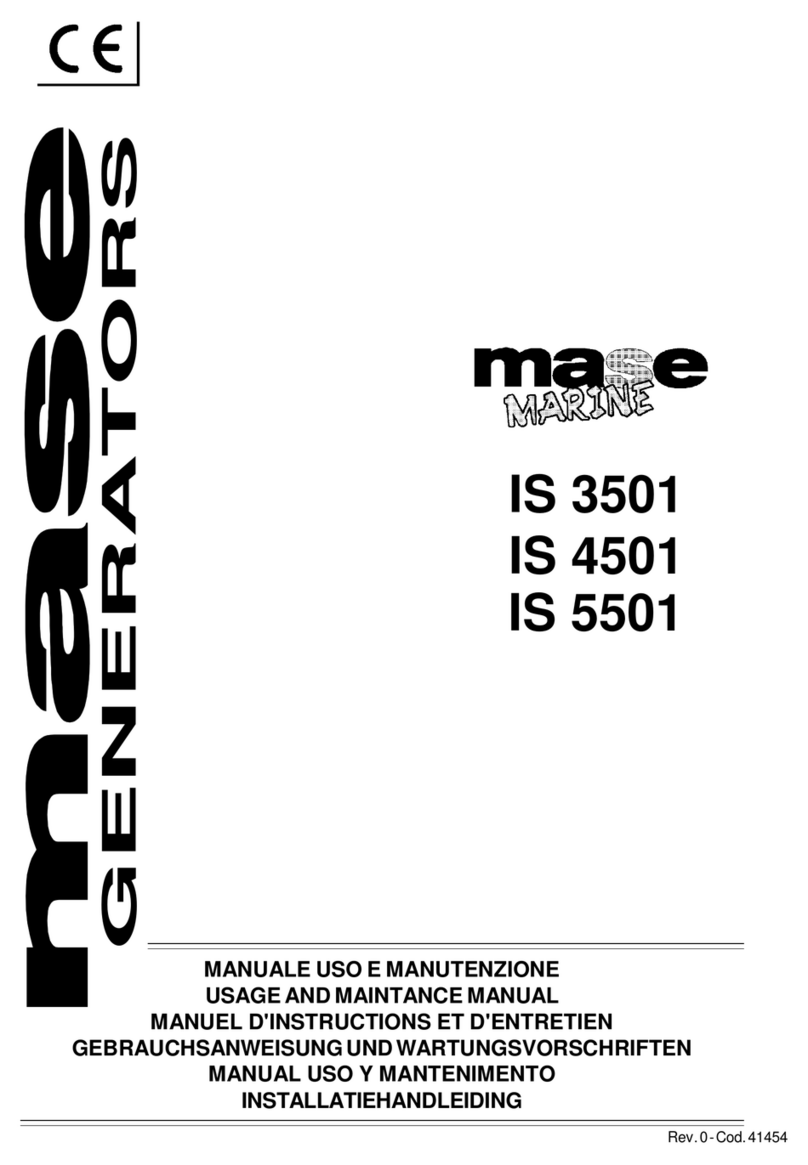
Mase
Mase IS3501 Usage and maintenance manual

LeCroy
LeCroy ArbStudio manual

Mitsubishi Electric
Mitsubishi Electric FR-A8AY E KIT instruction manual
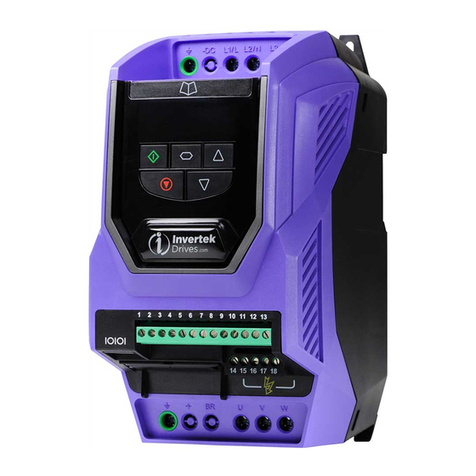
Invertek Drives
Invertek Drives Eco Optidrive ODV-3-220043-1F12-SN user guide
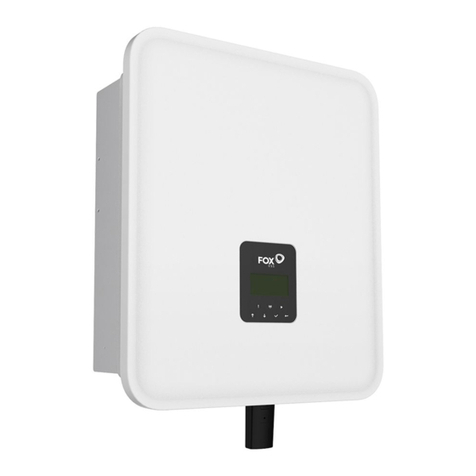
FoxESS
FoxESS H3 Series user manual
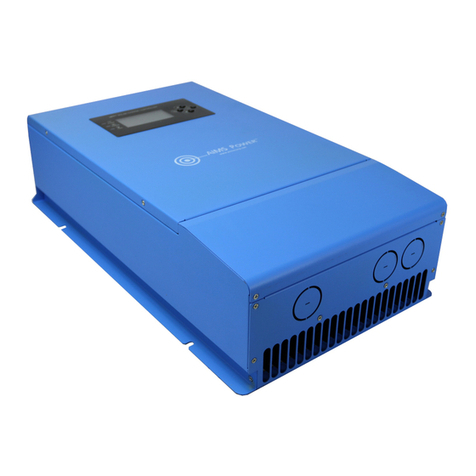
AIMS Power
AIMS Power SCC60-100A Installation and operation manual
